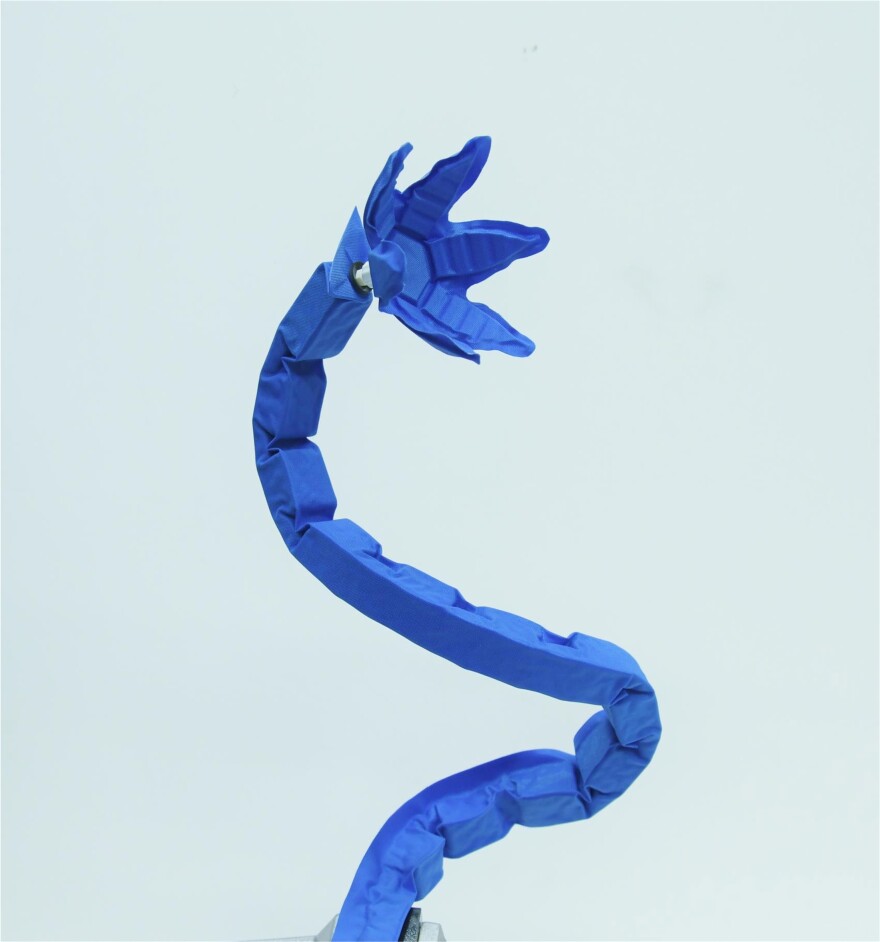The delicate art of paper folding is playing a crucial role in designing robotic artificial muscles that are startlingly strong. In fact, the researchers say they can lift objects 1,000 times their own weight.
The researchers say the muscles are soft, so they're safer compared to traditional metal robots in environments where they would interact with humans or delicate objects, and they can be made out of extremely low-cost materials such as plastic bags and card stock. Their findings were published this week in Proceedings of the National Academy of Sciences.
"It was surprising that they were so strong. ... I was surprised based upon the simplicity of this architecture, it's very simple," Robert Wood, a Harvard professor of engineering and applied sciences, tells The Two-Way.
"I still remember the first demo we saw of the system lifting a tire – and it was like whoa, we've got to model this," adds Daniela Rus, director of MIT's Computer Science and Artificial Intelligence Laboratory.
The artificial muscles work by encasing in a plastic "skin" a folded origami-like "skeleton" capable of expanding and contracting. The device expands as water or air is pushed into it, and contracts as the water or air is pumped out. Rus explains how this works:
"The fluid medium fills the entire space between the skeleton and the skin and in the initial stage the pressure of the internal and external fluids are equal. But as the volume of the internal fluid is changed, a new equilibrium is achieved.
"And this is due to the pressure difference between the internal and external fluids that induces tension in the flexible skin and the tension acts on the skeleton and in turn drives the transformation that is defined by the geometric structure of the skeleton. So if the skeleton compresses as a brick shape, that is the transformation you will achieve."
The researchers say the way that the origami skeleton is folded determines the motion that the artificial muscles will make as they expand or contract. They can be programmed, or folded, to move along multiple axes and to bend and rotate.

Because it is able to lift heavy payloads, the design, Wood says, overcomes a core paradox of the field of soft robotics: "You're typically giving up strength because you're using soft materials."
The devices are so strong, Rus says, because their design amplifies force much like a pulley or a lever does. As the origami structure inside contracts, and the outer plastic skin pulls in, it converts "the fluid pressure to a large tension force on the skin." Based on their models, she says the researchers believe a 1 kilogram artificial muscle could lift 1,000 kilograms.
Wood adds that he sees these models working well in environments like homes or hospitals, where they might interact with humans. "They're strong so we can envision things that have standalone robotic arms, that can manipulate large heavy objects yet be safe to operate around," he says.
Other applications could be wearable robots or robots used in surgery – "things that have to be delicate in order to not harm an operator or user, yet strong enough to lift heavy loads," Wood says.
Rus adds that she envisions these artificial muscles helping people who use wheelchairs to stand. "We could really bring soft strong mobility to people who are otherwise unable to move."
An upcoming challenge for the team is to mimic a prime example from nature of power and softness: they want to design a robotic elephant using these artificial muscles, capable of lifting heavy loads with soft materials.
Copyright 2021 NPR. To see more, visit https://www.npr.org.






